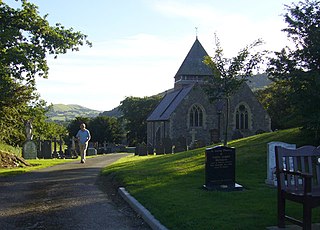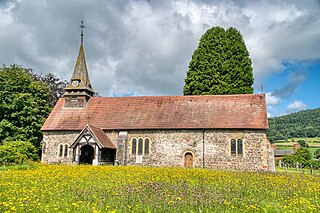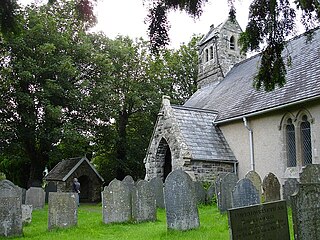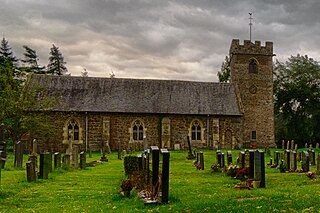
Welshpool is a market town and community in Powys, Wales, historically in the county of Montgomeryshire. The town is four miles from the Wales–England border and low-lying on the River Severn. The community, which also includes Cloddiau and Pool Quay, has a population of 6,664, with the town having 5,948. There are many examples of Georgian architecture within the town. Powis Castle is located to the north.

Llandinam is a village and community in Montgomeryshire, Powys, central Wales, between Newtown and Llanidloes, located on the A470. As a community, Llandinam is made up of the village itself, small hamlets including Plas Dinam and Little London and several farms. The village itself has a population of around 576 with 56% born in Wales.

Chirbury is a village and former civil parish, now in the parish of Chirbury with Brompton, in the Shropshire district, in west Shropshire, England. It is situated in the Vale of Montgomery, close to the Wales–England border, which is to its north, west and south. The A490 and B4386 routes cross at Chirbury.

Llanfyllin is a market town and community in Powys, Wales. The community population in 2021 was 1,586 and the town's name means church or parish (llan) of St Myllin. The community includes the settlements of Bodfach, Ty Crwyn, Abernaint and several farms.

Old Church Stoke is a village in the community of Churchstoke in Powys, Wales. Until 1974 it was in the county of Montgomeryshire.

Bacheldre is a small settlement in Powys, Wales. It is near the A489 road and is 5 kilometres (3 mi) southeast of the town of Montgomery.

St Garmon's Church, Llanfechain, is in the village of Llanfechain, Powys, Wales. It is an active Anglican parish church in the deanery of Llanfyllin, the archdeaconry of Montgomery, and the diocese of St Asaph, and is designated by Cadw as a Grade II* listed building. The church is traditionally associated with a 9th-century Celtic saint, St Garmon. St Garmon was most likely St Germanus (410–474), the first Bishop of Man. It shares it name with the church in the village of St Harmon in Radnorshire (Powys), where the diarist Francis Kilvert was a curate.

St Berres' Church, Llanferres, is in the village of Llanferres, Denbighshire, Wales on the A494 road between Mold and Ruthin. It is an Anglican church in the Bro Famau Group of Churches, the Mission Area of Mold, the archdeaconry of Wrexham and the diocese of St Asaph. The church is designated by Cadw as a Grade II listed building.

Llangadfan is a small village in Powys, Wales, based in the community of Banwy. The village lies on the A458 between Foel and Llanerfyl, 12 kilometres (7.5 mi) from Llanwddyn. Dyfnant Forest is located nearby. The village is said to be known for its country dances.

Snead is a small village in Powys, Wales.

Castle Caereinion is a small village and community in Montgomeryshire, Powys, Wales, upon the River Banwy, around 8 miles west of Welshpool, and 4 miles east of Llanfair Caereinion.

Hyssington is a parish in the South-Eastern corner of the historic county of Montgomeryshire in Wales and borders the county of Shropshire in England. It is now within the area of the Church Stoke community council in Powys. It is dominated by Corndon Hill. The church which is in the Diocese of Hereford lies just the north of a small village and is sited just to the west of a medieval Motte-and-bailey castle. This area was also the source of late Neolithic and Early Bronze Age battle-axes and axe-hammers, made from picrite that were widely traded around 2000 BC.

St Michael's Church is the parish church of Kerry, in the historic county of Montgomeryshire, now Powys. Kerry is sited about 3 miles to the S E of Newtown. which suggests that there may have been a church on the site since the 7th century. The church stands in an almost oval churchyard in the centre of the village. It was rebuilt and re-dedicated in 1176. Of the original church only the north aisle arcade survives, and the chancel arcade is 14th-century in date. The square stone tower is surmounted by a Montgomeryshire style timber-framed belfry. The main body of the church was rebuilt in 1882–83 by the architect George Edmund Street, paid for by James Walton of Dolforgan Hall. The church is a Grade I listed building.

St Nicholas's Church, formerly called St Mary's Church until 1881, is a Church of England parish church in Church Stoke, Powys, Wales. The church's current building is largely the result of 19th-century reconstruction, but it retains its 13th-century tower with a later timber belfry. From the period prior to the 19th century, only a font, a stoup and a chest have survived up to three phases of restoration and reconstruction. The main body of the church with its large high pitched roof dates to the second half of the 19th century. It is a Grade II listed building.

Mochdre is a small village in the community of Mochdre with Penstrowed, in Montgomeryshire, Powys, Wales.

St David's Church is an active parish church in the village of Llanddew, Powys, Wales. It stands next to the castle, some 2km to the north-east of Brecon. It is traditionally associated with Gerald of Wales, who served as Archdeacon of Brecon and lived in the castle in the late 12th century. Ruined by the mid-19th century, the church was restored by Ewan Christian. St David's is designated by Cadw as a Grade I listed building.

St Cewydd's Church is an active parish church in the village of Disserth, Powys, Wales. The dispersed village of Disserth lies south of Llandrindod Wells and north of Builth Wells. The church stands in an isolated position on a bank of the River Ithon. Unrestored in the Victorian era, the church has an unusually complete 18th century interior. Medieval in origin, St Cewydd's is designated by Cadw as a Grade I listed building.

The Church of St Tysilio and St Mary is an active parish church in the village of Meifod, Powys, Wales. The village lies seven miles (11 km) north-west of Welshpool. The site has been a centre of Welsh Christianity since c.500 and the present, unusually large, churchyard forms part of what was an early clas settlement. The origins of the present church are of the 12th century. The dedications are to Tysilio and to Mary, mother of Jesus. Tysilio was a 6th/7th century Welsh noble and Bishop of St Asaph who reputedly founded an early church, the Eglwys Tysilio, at Meifod. The church is a Grade I listed building. The Royal Commission on the Ancient and Historical Monuments of Wales (RCAHMW) considers Ss Tysilio and St Mary, "a display of Welsh Christianity through the centuries".

St Aelhaiarn's Church is an active parish church in the village of Guilsfield, Powys, Wales. The village lies 3 miles to the north of Welshpool. The present church dates mainly from the 14/15th centuries, although parts may date back to the 12th. It was restored by George Edmund Street in 1877–1879. The church is designated by Cadw as a Grade I listed building. Its churchyard, which contains a group of ancient yew trees, is designated at Grade II* on the Cadw/ICOMOS Register of Parks and Gardens of Special Historic Interest in Wales.

St David's Church is an active parish church in the village of Glascwm, Powys, Wales. It stands in a circular churchyard in the centre of the village, some 9m to the north-east of Builth Wells. It is traditionally associated with Saint David and there was likely an early clas settlement on the site. The church was restored by Ewan Christian in 1891. St David's is designated by Cadw as a Grade I listed building.
























